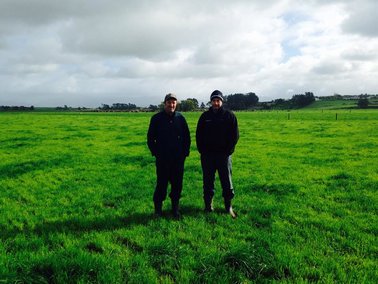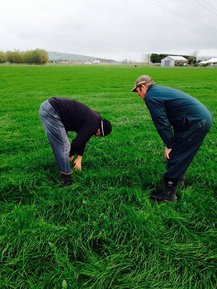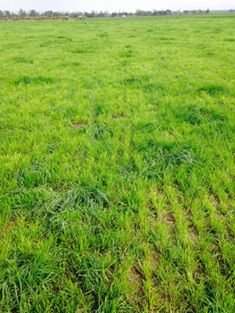Trojan growing twice the average DM/ha for Cameron Woodhouse, Carterton
Carterton 11 June: Even though he knew some paddocks were not growing as well as others this past season, Cameron Woodhouse says he was still startled to find out just how big the difference was in terms of DM/ha.
Pasture Coach data shows the best paddocks on the farm he contract milks grew approximately 14 t DM/ha while the least productive grew 7 t DM/ha.
Cameron’s been flat out drying off cows and sending 800 of them away to winter grazing but says now that job is behind him he can look more closely at the both the good and not so good paddocks, where they are located on the farm and reasons for the way they have performed.
Having the pasture growth information has also helped identify possible sacrifice areas for calving, if required, as well as potential cropping paddocks for the season ahead.
After finishing up 4% ahead of last season, with the highest total MS production they’ve yet achieved on the 330 ha Wairarapa property, the Woodhouses are reasonably confident about their preparations for winter.
 The herd dried off at the same or better BCS than in previous years, and the winter blocks are well set up to feed all but 70 cows, which Cameron has kept at home to take a bit of pressure off the run offs.
The herd dried off at the same or better BCS than in previous years, and the winter blocks are well set up to feed all but 70 cows, which Cameron has kept at home to take a bit of pressure off the run offs.
He also has 100 R1 heifers on the milking platform, ‘to keep the young Barenbrug grasses under control!’
He’s only partly joking on this topic; new Trojan pastures were plated at up to 100 kg DM/ha/day in late autumn while the farm average was 40 kg DM/ha/day and Trojan continues to have the edge as growth rates begin to ease back with cooler temperatures and shorter days.
On the latest walk this week, the farm average cover was 1960 kg DM/ha and average growth rate 16 kg DM/ha/day, with the new pastures double at 32 kg DM/ha/day.

Planned start of calving is 20 July; Cameron’s aiming for a target cover of 2300 kg/DM/ha by then and says they usually get through early spring without too many feed issues. “We don’t normally have to feed silage in the spring, we usually just follow the cows with urea in a truck. If we can’t get a truck over a paddock, that means it’s too wet to feed out silage anyway.”
Few major changes have been signalled in the wake of the lower payout for the season ahead; turnips and greenfeed maize are again part of the plan for summer crop, and there was no skimping on animal health inputs for the cows at dry off.
“I’d like to do some grass to grass renewal on top of the cropping land now that we have more irrigation, but it will depend on the spring,” Cameron says. “Capital spending may be cut this year. We’ll just have to wait and see.”
The latest big development – a new effluent system including a 1 ha pond – has been designed to future proof the farm, which peak milks more than 1000 cows.

